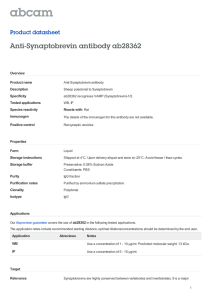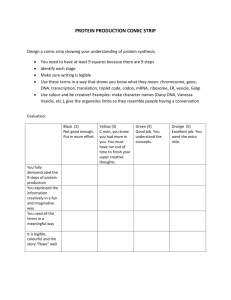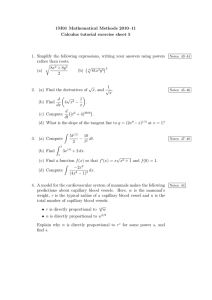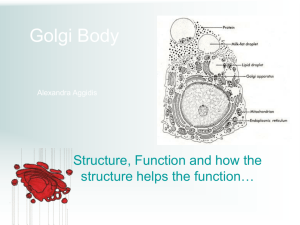Mesoscale simulation of blood flow in microcapillaries Matti Peltom¨aki
advertisement
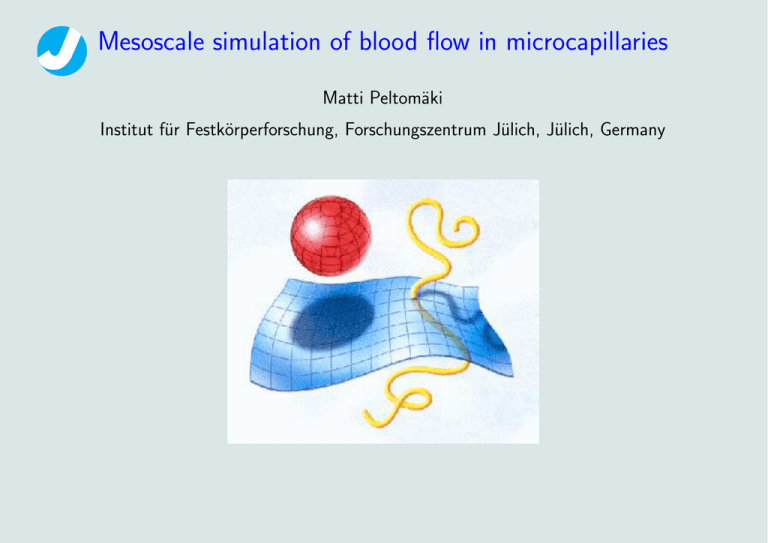
Mesoscale simulation of blood flow in microcapillaries Matti Peltomäki Institut für Festkörperforschung, Forschungszentrum Jülich, Jülich, Germany Work done during the last year in the Soft Matter Theory group in Jülich. Involved people include • Hiroshi Noguchi (now in Tokyo) • J. Liam McWhirter (now in Helsinki) • Julia Fornleitner • Dmitry Fedosov • Matti Peltomäki • Prof. Gerhard Gompper Soft Matter Hydrodynamics Cells and vesicles in flow: • Red blood cells in microvessels: Diseases such as diabetes reduce deformability of red blood cells! Mesoscale Simulations Complex fluids: length- and time-scale gap between • atomistic scale of solvent • mesoscopic scale of dispersed particles (colloids, polymers, membranes) −→ Mesoscale Simulation Techniques Basic idea: • drastically simplify dynamics on molecular scale • respect conservation laws for mass, momentum, energy Examples: • Lattice Boltzmann Method (LBM) • Dissipative Particle Dynamics (DPD) • Multi-Particle-Collision Dynamics (MPC) Mesoscale Simulations: MPC Multi-Particle-Collision Dynamics (MPC) • coarse grained fluid • point particles • off-lattice method • collisions inside “cells” • thermal fluctuations A. Malevanets and R. Kapral, J. Chem. Phys. 110 (1999) A. Malevanets and R. Kapral, J. Chem. Phys. 112 (2000) Mesoscale Simulations: MPC Flow dynamics: Two step process Streaming • ballistic motion ri(t + h) = ri(t) + vi(t)h Mesoscale Simulations: MPC Flow dynamics: Two step process Streaming Collision i • ballistic motion ri(t + h) = ri(t) + vi(t)h • mean velocity per cell Pni 1 v̄i(t) = ni j∈Ci vj (t) • rotation of relative velocity by angle α vi′ = v̄i + D(α)(vi − v̄i) Mesoscale Simulations: MPC • Lattice of collision cells: breakdown of Galilean invariance • Restore Galilean invariance exactly: random shifts of cell lattice T. Ihle and D.M. Kroll, Phys. Rev. E 63 (2001) Mesoscale Simulations: MPC • Lattice of collision cells: breakdown of Galilean invariance • Restore Galilean invariance exactly: random shifts of cell lattice T. Ihle and D.M. Kroll, Phys. Rev. E 63 (2001) Mesoscale Simulations: Reynolds and Schmidt Numbers • Reynolds number Re = vmaxL/ν ∼ inertia forces / friction forces For soft matter systems with characteristic length scales of µm: Re ≃ 10−3 • Schmidt number Sc = ν/D ∼ momentum transp. / mass transp. Gases: Sc ≃ 1, liquids: Sc ≃ 103 1000 Sc 100 10 α=130,ρ=30 α=130, ρ=5 α=90, ρ=5 α=45, ρ=5 α=15, ρ=5 1 0.1 0.01 0.1 h 1 10 M. Ripoll, K. Mussawisade, R.G. Winkler and G. Gompper, Europhys. Lett. 68 (2004) Membranes and Vesicles: Equilibrium Shapes Minimize curvature energy for fixed area A = 4πR02 and reduced volume V ∗ = V /V0, where V0 = 4πR03/3: stomatocyte discocyte U. Seifert, K. Berndl, and R. Lipowsky, Phys. Rev. A 44 (1991) prolate Membranes and Vesicles: Different Length Scales atomistic coarse-grained solvent-free triangulated Membranes and Vesicles: Triangulated Surfaces Two- and many-body potentials: • Bending rigidity κ • Pairwise soft repulsion • Pairwise soft attraction (in • Closed 2D surface in 3D. • N vertices (membrane particles) • 3(N − 2) edges the presence of an edge) • Surface area constraint • Volume constraint • 2(N − 2) faces G. Gompper, D.M.Kroll, J. Phys. Cond. Matt 9 (1997); G. Gompper, D.M. Kroll, in Statistical Mechanics of Membranes and Surfaces (World Scientific, 2004) Membranes and Vesicles: Fluid Vesicles In fluid vesicles, the triangulation is dynamic: The membrane viscosity can be controlled through the bond-flip rate. Membranes and Vesicles: Red Blood Cells • Spectrin network (no bond flips) induces shear elasticity µ of composite membrane • For real RBCs: elastic parameters: κ/kB T = 50, µR02 /kB T = 5000 Membranes and Vesicles: Coupling to the Fluid Interaction between membrane and fluid: • Streaming step: bounce-back scattering of solvent particles on triangles • Collision step: membrane vertices are included in MPC collisions implies impenetrable membrane with no-slip boundary conditions. H. Noguchi and G. Gompper, Phys. Rev. Lett. 93 (2004); Phys. Rev. E 72 (2005) Capillary Flow: Results for one vesicle Capillary Flow: One Fluid Vesicle • small flow velocities: vesicle axis perpendicular to capillary axis −→ no axial symmetry! • discocyte-to-prolate transition with increasing flow H. Noguchi and G. Gompper, Proc. Natl. Acad. Sci. USA 102 (2005) Capillary Flow: One Elastic Vesicle Elastic vesicle: • curvature and shear elasticity (κ = 20 kB T , µ = 110 kB T /R02 ) • model for red blood cells parachute shape Capillary Flow: One Elastic Vesicle Elastic vesicle: • curvature and shear elasticity • model for red blood cells Tsukada et al., Microvasc. Res. 61 (2001) Capillary Flow: One Elastic Vesicle The discocyte–to–parachute transition takes place as a function of flow velocity vmτ /Rcap bending rigidity (µ = 110 kB T /R02) shear modulus (κ = 20 kB T ) Implies for RBCs: vtrans ≃ 0.2mm/s for Rcap = 4.6µm Capillary Flow: One Elastic Vesicle Pressure drop due to vesicle Hematocrit ratio HT /HD = vm/vves elastic vesicle fluid vesicle: discocyte △ parachute ⋄ prolate vesicle velocity larger than fluid ∆P = 8η0(vo − vm)Lz 2 Rcap velocity (Fåhraeus effect) H. Noguchi and G. Gompper, Proc. Natl. Acad. Sci. USA, 102 (2005) Capillary Flow: Results for several vesicle Capillary Flow: Clustering & Alignment Physiological conditions: Hematocrit (volume fraction of RBCs) H = 0.45 Lower in narrow capillaries HT = 0.1...0.2 Therefore: Hydrodynamic interactions between RBCs very important Note: No direct attractive interactions considered! Capillary Flow: Clustering & Alignment Low hematocrit HT : • Single vesicles more deformed → move faster • Effective hydrodynamic attraction stabilizes clusters J.L. McWhirter, H. Noguchi, G. Gompper, Proc. Natl. Acad. Sci. 106 (2009) Capillary Flow: Clustering & Alignment Low hematocrit HT : G(z*nb) 6 Positional v*0=7.7 =10 =10 4 a correlation function 2 0 0 1 2 3 4 5 * z 0.7 nb 0.6 P(ncl) 0.5 0.4 b 0.3 0.2 Probability for cluster size ncl 0.1 0 0 1 2 3 4 ncl 5 6 7 Clustering tendency increases with increasing flow velocity Capillary Flow: Clustering & Alignment High hematocrit HT : disordered discocyte aligned parachute zig-zag slipper J.L. McWhirter, H. Noguchi, G. Gompper, Proc. Natl. Acad. Sci. 106 (2009) Capillary Flow: Clustering & Alignment High hematocrit HT : disordered discocyte aligned parachute zig-zag slipper Skalak, Science, 1969 Capillary Flow: Clustering & Alignment Phase diagram: Hematocrit HT = 0.28/L∗ves Transition to zig-zag phase despite higher flow resistance than alignedparachute phase! 2 4 6 8 10 flow velocity v0∗ 12 Summary • Mesoscale simulation techniques are powerful tool to bridge the length- and time-scale gap in complex fluids • Multi-particle-collision dynamics well suited for hydrodynamics of embedded particles: colloids, polymers, vesicles, RBCs • Red blood cells in capillary flow: shear elasticity implies parachute shapes, hydrodynamic clustering and alignment Review: G. Gompper, T. Ihle, D.M. Kroll, R.G. Winkler, Adv. Polym. Sci. 221, 1 (2009)

